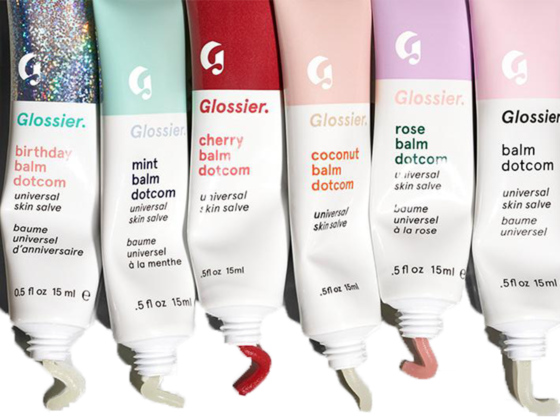THE PRODUCT
INNISFREE: MY LIP BALM
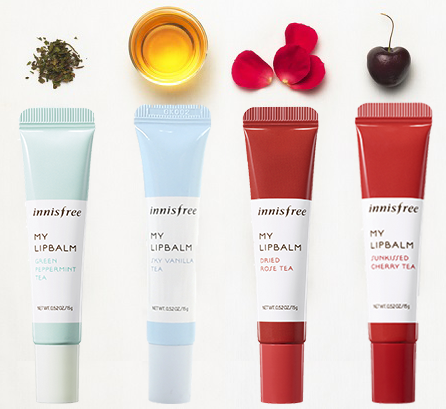
I’ve reviewed a slew of U.S. and European-based brands, but haven’t really delved into Asian brands. Well, today’s the day, folks! And just so you know, dear friends, this won’t be the last. Many more to come! But we’ll start with the Korea-based brand, Innisfree. More specifically, review Innisfree My Lip Balm. Three reasons:
- This will piggyback our review of Glossier’s Balm Dotcom and its six flavors.
- Of the six Glossier Balm Dotcom flavors, Innisfree My Lip Balm offers four similar options.
- Innisfree (the product child of Amore Pacific) is currently available in the United States and online.
Asian beauty brands…
This topic has been a long time coming. In the last five years, Asian beauty brands have given European and American companies a dose of heavy competition. In fact, both Korean beauty (K-Beauty) and Japanese (J-Beauty) brands have essentially given Euro/American beauty companies a heavy dose of humble pie. This topic is very close to my heart being an Asian-American and having longed for recognition of viable products having its origins from Asia.
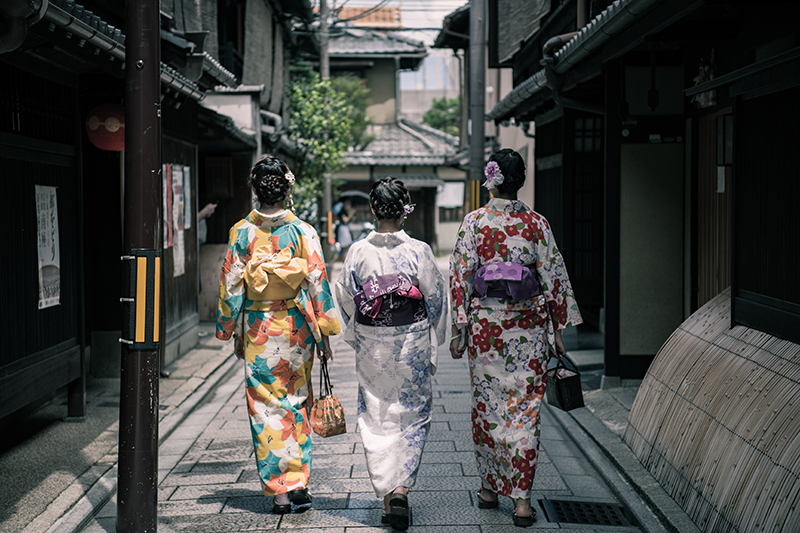
What do I mean by this?
Before, if you lived in Europe or the U.S., you would have to search far and wide on the internet (or travel) for Asian brands. Fast forward the last few years and now you can’t walk into a drugstore (like CVS or Target), cosmetic store (like Sephora or Ulta Beauty), or even trending clothing stores (like Urban Outfitters or Anthropologie) without seeing some form of Asian beauty brand.
It’s just not possible.
So why all the fuss? Well, for one thing, Asian beauty (along with European beauty) have always been at the forefront with respect to specialized ingredients, amplifying botanical materials, and utilizing the best technologies in formulating their products. And let’s not forget their aesthetically and functionally pleasing packaging. But until recently, the American audience was never exposed to these innovative products.
Until now.
And since this newfound wave of interest, an explosion of products and brands have flooded the U.S. markets. So much so, it often becomes overwhelming; even daunting.
What do I try? Which brand is best? Fermented ingredients? Probiotic skincare?
Don’t get me wrong, there have been some very seasoned Asian brands that are certainly recognizable to American and European markets for quite some time – such as Japanese-based brands, Shiseido or Shu Uemura. Both oldies, and definitely goodies.
In any case, K-Beauty and J-Beauty are hot right now.
Here is a small list of Japanese and Korean brands that have surfaced more recently:
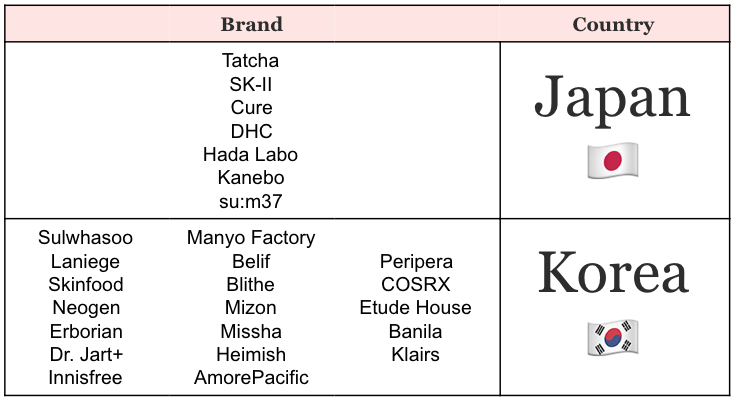
But that doesn’t mean other Asian countries (like Thailand, Singapore, Indonesia, Taiwan, and China) don’t have their own take or local brands worth discussing.
And we hope to delve more deeply into some of these brands in the future.
But for now, we will focus on Korean beauty!
THE INGREDIENTS
My Lip Balm #01 (Green Peppermint Tea)

Petrolatum (also known as petroleum jelly) is often associated with the brand Vaseline.
Do you remember Vaseline? And that large yellow-beige tub with the blue cap?

Petrolatum is often a common and classic moisturizer; used in the prevention of skin infections such as after ambulatory surgeries and maintenance therapy of atopic dermatitis. It is a complex combination of hydrocarbons which is able to have a long shelf life due to its processing. As a moisturizing product, it is classified as an “occlusive” which are substances that have been found to physically block transepidermal water loss (TEWL).
One thing to note is that a 1992 study examined the assumption that the petroleum jelly in Vaseline was occlusive; able to block TEWL and trapping water under the skin’s surface. Interesting enough, the study concluded that the petroleum jelly in Vaseline neither forms nor acts like an epicutaneous impermeable membrane; instead, it permeated throughout the stratum corneum (upper skin layer) interstices, which allowed for normal barrier recovery despite its occlusive properties.
Either way, there have been numerous studies and research regarding petrolatum and its topical effects of the skin. Here are just some interesting tidbits:
- A 1971 study determined that petrolatum was one of the best moisturizers with having a water vapor loss resistance 170 times that of olive oil. However, it is cosmetically less acceptable due to its greasiness.
- A 2001 letter determined that petrolatum (at a minimum concentration of 5%) may reduce TEWL by more than 98% followed by lanolin, mineral oil, and silicones which only reduce TEWL by 20–30%.
- A 2016 study evaluated the cutaneous molecular and structural effects induced by petrolatum. The study concluded that application of petrolatum induced expression of key barrier differentiation markers (filaggrin and loricrin), increased stratum corneum thickness, and significantly reduced T-cell infiltrates in the setting of “normal-appearing” or non-lesional atopic dermatitis skin. In short, petrolatum robustly modulates antimicrobials and epidermal differentiation barrier measures.
One thing to note: Although known for its performance as a moisturizing agent; petrolatum often has side effect indications for occlusive folliculitis.
Bottom line: Occlusive moisturizing agent often used for its capabilities of reducing TEWL by more than 98%.
Hydrogenated castor oil dimer dilinoleate (or sometimes called ricinus communis seed oil) produced from castor beans functions primarily as skin-conditioning agents, emulsifiers, surfactants, and cleansing agent in cosmetic products. Castor oil is known to consist of up to 90% ricinoleic acid:
- 4% linoleic acid (Omega-6)
- 3% oleic acid (Omega-9)
- 1% stearic acid
- Less than 1% linolenic fatty acids (Omega-3).
This isn’t the new kid on the block. In fact, castor oils origins stem from Eastern Africa, China, and India approximately 1,400 years ago as a raw material! But it was not until 1988, that castor oil was evaluated for its transepidermal water loss (TEWL) potential. The study concluded that castor oil (in addition to other occlusive agents: mineral oil and sesame seed oil) showed a decrease in TEWL rate.
Bottom line: Castor oil is an occlusive agent that shows a reduction in TEWL.
This is a wax derived from petroleum and characterized by the fineness of its crystals in contrast to the larger crystals of paraffin wax. Waxes are often used in skin and lip care cosmetic products due to their excellent skin tolerance as well as their high protecting and cleansing performance and broad viscosity options. In fact, a review published in 2017, evaluated 13 in vivo (human and animal) and in vitro studies investigating overall dermal penetration of mineral oil and waxes. The review concluded that mineral oils and waxes are 1) absorbed to the upper layer of the skin (stratum corneum), 2) minor fraction is actually absorbed deep within the skin layer, 3) there is no evidence that its percutaneously absorbed (organ absorbed), and 4) cosmetic use is unlikely to represent a systematic human health risk after long-term exposure. Another important detail is that the average molecular weight of microcrystalline wax ranges between 500-800 g/Mol (Da). This is important due to the 500 Dalton rule – which I will go into further detail in another post. But briefly, based on an article published in 2000; under the 500 Da rule, it is thought that all common contact allergens are under 500 Da and larger molecules (greater than 500 Da) are typically non-irritating. Of course, this would be a difficult rule to test out entirely – as all compounds can’t possibly be categorized based on molecular weight and tested for specific dermal sensitivities. Bottom line: So based on this review, how are waxes beneficial to this formulation? If we take into account that it provides a nice protective shield (as wax tends to do) and is relatively safe based on reviews and research — then it does make sense as to why Innisfree would include wax. However, this type of wax is certainly up for discussion as I could not find finite published benefits.
Beeswax is a structure that forms out of honeycomb. Bees secrete this waxy material to build their lovely honeycomb hive in order to protect and store honey. Therefore, it makes sense that beeswax itself is rich in hydrophobic protective properties – more specifically, hydrocarbons, free fatty acids, esters of fatty acids & alcohols, and various exogenous substances.

In the past, the pharmaceutical industry has used beeswax as a key ingredient to prepare ointments and creams to soothe wounds. This really hasn’t changed much even with present-day modernization. However, scientists and researchers have discovered the antimicrobial benefits and properties of beeswax. Providing as a good alternative to harsher synthetic chemicals that thwart microbial growth in formulations and products. Even determining that not only is beeswax helpful as an anti-inflammatory source but when coupled with olive oil has been proven to be effective for the treatment of atopic dermatitis and psoriasis.
Bottom line: Beeswax is a natural material with protective strength from its fatty acids and hydrophobic properties. Creating an amazing moisturizing material. Plus it is a good natural alternative for its anti-inflammatory and antimicrobial properties!
According to a comprehensive analysis of seed oils performed in 1992, Sunflower oil contains high levels of vitamins A, D, and K – with crude sunflower oil having the highest content of vitamin E in the form of α-tocopherol amongst oils.
In a randomized study in 2013, sunflower seed oil preserved stratum corneum integrity (that’s skin talk) – and improved hydration in volunteers who applied it topically after 4 weeks. Oddly enough, the study also found that in contrast; topical treatment of sunflower oil WITH olive oil significantly damaged the skin barrier, and therefore had the potential to promote the development of and exacerbate existing atopic dermatitis. Thankfully, none of the Innisfree My Lip Balm flavors reviewed include olive oil.
Bottom line: High vitamin E content for improved hydration. Based on the 2013 study, folks who are sensitive to atopic dermatitis need to be aware that this product may exacerbate the condition.
The name of this has always made me laugh. In fact, a childhood friend of mine and I would always chuckle at the sound of this ingredient in products. Was it “ho-ho-ba” or was it “joe-joe-ba”? Either way, you pronounce it – it’s a functional vehicle for providing natural hydration, moisturizing, and firming capabilities synergistically with other key extracts and essential oils. A number of reviews from scientific literature suggest that jojoba has anti-inflammatory effects and can be used on a variety of skin conditions including skin infections, skin aging, as well as wound healing.
In fact, a 2010 study assessed the hydration and viscoelastic effect of moisturizers containing different herbal ingredients (including jojoba oil) – after 3 weeks of topical application to the skin. The study found that there was a significant increase in skin viscoelasticity (90-95%) and increase in water content of the stratum corneum (upper layer of the skin) by 60-70%.
Bottom line: This funny sounding oil enhances the penetration of whatever is synergistically formulated into the product. It also provides hydration and promotion of skin elasticity!
Cacao, one of the top raw material sources for a multibillion-dollar food industry. Whether you are a chocoholic or not – cacao and its derivatives have long been used in various foods.
The pulp of the fruit of the Theobroma cacao tree is the source of cocoa butter (or cupuacu butter)– a natural lipid rich in saturated fatty acids that are stored in the form of triacylglycerides. In fact, scientists have determined with its abundant polyphenol and flavonol composition – cacao seed butter may influence healing properties –improving dermal blood flow, increasing photoprotection and ultimately contributing to the maintenance of skin health!
In fact, we are just scratching the surface of its neuroprotective benefits as well as its antioxidant properties – which all began from the Aztec and Mayan civilizations! Nowadays, it is considered a modern plant-based alternative to lanolin, which can often be a sensitizer and allergen.
A water absorption study was performed with each of the following: cupuacu, shea butter, and lanolin (stirring until separation was observed). The study concluded that cupuacu could support 440% of its weight in water, which means that 1 kg of cupuacu butter could absorb 4.4 kg of water; allowing it to function much more effectively as a skin hydrator and plumper.
In 2003, the chemical composition of cupuacu butter was evaluated and found to be rich in:
- Phytosterols (or plant sterols) which combat free radicals; to benefit dry, damaged skin and
- Polyphenols to combat free radical damage
- Fatty acids to protect and moisturize the skin
- 18.8 % Oleic acid (Omega-9)
- 55.2% Palmitic acid
- 3.1% Linoleic acid (Omega-6)
- 18.0% Linolenic acid (Omega-3)
Bottom line: Provides photo-protective, helps to improve dermal blood flow, maintain overall skin health, skin hydrator and plumper.
Silica silylate is the hydrophobic silica derivative and functions as an anti-foaming agent, anti-caking agent, bulking agent, binder, skin-conditioning agent, emollient, and viscosity increasing agent in cosmetics.
Silica is abundant and makes up of 26% of the Earth’s crust by weight. It is found primarily in rocks, sand, and clay. Sounds a lot like Mica, huh? In fact, mica is a form of silica! Along with clay (as mentioned before), quartz, emerald, talc, glass, etc.
In its purest form – silica is unable to exist in its natural state due to its propensity to react with the atmosphere (i.e. Oxygen). Therefore silica – is actually silicon dioxide. And generally speaking, there are two forms of silica – crystalline and amorphous. At present, the amorphous form processed synthetically; is traditionally used in cosmetics as an absorbent, anti-caking agent, and suspending agent.
Did you know that it is the third most abundant trace element in the human body? And silicon has been suggested that to improve skin strength and elasticity and pivotal in collagen synthesis? And it is suggested that a higher silicon content in the hair results in a lower rate of hair loss and increased brightness. Well, now you do!
In fact, in a study of women aged 40 to 65 with typical signs of photoaging — intake of a bioavailable form of silicon supplements saw a significant improvement after 20 weeks in skin surface characteristics and in its mechanical properties. The study also observed significant improvement in the fragility of nails and hair compared to the placebo group after a nine-month period.
Bottom line: Silica (or silicon) is safe as it is clearly an abundant element within nature and your body; with studies pointing to its positive effects on skin elasticity and improvement in photo-aged skin. Silica silylate is the hydrophobic silica derivative and functions as an anti-foaming agent, anti-caking agent, skin-conditioning agent, emollient, and viscosity increasing agent in cosmetics.
Isostearic acid is a mixture of branched-chain 18 carbon aliphatic acids (fatty acid salts) and often function as an anti-caking agent, emulsion stabilizer, viscosity increasing agent, opacifying agent, surfactant, skin-conditioning agent, antioxidant, fragrance ingredient, colorant, skin protectant, cosmetic biocide, and film former in cosmetics. Isostearic acid is the salt and ester of stearic acid or stearate.
Stearic acid is a saturated long-chain fatty acid found in various animal and plant fats. In cosmetics, it is commonly used as an anionic emulsifier and is also a major component of cocoa butter and shea butter.
A study in 2010, evaluated the amount and location of stearic acid (from a formulated cleanser) in the corneum (layer of the skin) after in vivo cleansing. They concluded that the estimated total fatty acid delivered to skin from cleansing is comparable to the amount of fatty acid in a corneum layer. Basically what was delivered was what was found on the skin layer.
Ok, now for the important stuff.
A 1989 study evaluated the skin penetrating effects of varying branched fatty acids, including isostearic acid. The study concluded that the longer branched chain form (c18) of isostearic acid was more effective in enhancing skin penetration as compared to its shorter branched chain version (C2)
Bottom line: A fatty acid which often functions as an anti-caking agent, emulsifier, surfactant, skin-conditioning agent, antioxidant, skin protectant, and film former in cosmetics.
Mentha viridis (spearmint) leaf oil is a volatile oil obtained from the dried tops and leaves of mentha viridis. Peppermint oil is a hybrid of spearmint (mentha spicata or mentha viridis) and water mint (mentha aquatica). Both are synonymous with mentha oil, mentha piperita (peppermint) oil. Menthol is a synthetic compound obtained from mentha piperita (peppermint) oil.
Peppermint is a popular herb most notably extracted for its pungent menthol oil. It’s widely used in cosmetics, personal hygiene products, foods, and fragrant applications. It has varying therapeutic properties and often used in aromatherapy, bath preparations, mouthwashes, toothpaste, and topical preparations.
In 2001, a safety assessment was performed and found the oil to primarily be used in cosmetic formulations as a fragrance component. The oil itself is composed of menthol and menthone. Isolated clinical cases of irritation and/or sensitization were reported due to peppermint oil application and/or its constituents. However, peppermint oil (at 8%) itself was not a sensitizer when tested using a maximization protocol.
And finally, a 2010 study found that the essential oil of mint may be exploited as a natural source of bioactive phytochemicals bearing antimicrobial and antioxidant potentials that could be supplemented for both nutritional purposes and preservation of foods.
Bottom line: This essential oil provides a pungent menthol (clean smelling) fragrance with evidence pointing to its antioxidant and antimicrobial properties.
Tocopheryl acetate is the acetate ester form of Tocopherol – which is the most prevalent form of vitamin E in plant seeds and products derived from corn, sesame seed, sunflower, olive oils, and a plethora of nuts.
Baffled Side Note: Similar to Glossier, I’m not quite sure why Innisfree lists both tocopheryl acetate AND tocopherol in their ingredients list but not together, as one is the synthetically derived acetate derivative of the other. Seems a bit redundant since the overall molecule itself is the same.
In addition, studies have also determined that free vitamin E (tocopherol) is much more sensitive to oxidative degradation, compared to the acetate derivative (tocopheryl acetate); which may be attributed to the larger molecule (acetate component).
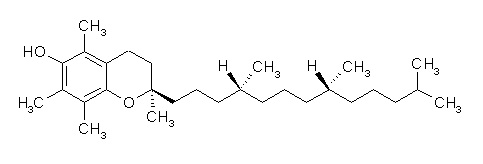

Most of the tocopherols are reported to function in cosmetics as antioxidants or skin conditioning agents. In fact, a 2003 study, evaluated whether the combination of topical vitamin C and E was better for UV protection to the skin than an equivalent concentration of each – alone. The study concluded that each (in their own right) were significant antioxidants in the protection from skin damage. However, the combination of both C and E provided superior synergy against the likes of skin cancer and photoaging. Further detailed information regarding tocopherol as a major lipid-soluble chain-breaking antioxidant of membranes and an important cellular protectant against oxidative damage was provided in a 2014 safety assessment.
It is also interesting to note that in 1999, a study found that topical vitamin E applied on scars provided no benefit (in 90% of the cases) to the cosmetic outcome of scars after skin surgery. And it even noticed that 33% of the patients treated, developed contact dermatitis to the vitamin E.
Overall, tocopherol is the predominant form of vitamin E in human and animal tissues, and it has a high bioavailability. The safety assessment recognized that tocopherol has some absorption in the UV range. However, it was noted that according to animal and clinical testing, tocopheryl acetate was not photo-allergenic or phototoxic.
Bottom line: Strong antioxidant capacity. Best if formulated with vitamin C ingredients but may be a potential for dermatitis.
Dehydroacetic acid often functions as a preservative at concentrations of less than 1%. Other than that, not much was really found on this specific compound as far as published studies or data. However, the CIR panel has deemed this safe.
Based on trademarked vendor compounds, dehydroacetic acid may be the following:
- A good fungicide and a mild bactericide, Lonza (Geogard® 111A).
- An excellent preservative to protect all type of cosmetic formulations used as standalone active or combined with other organic acids, phenoxyethanol or additives that enhances its activity (boosters), Chemipol (BIOPOL).
Bottom line: Dehydroacetic acid is a preservative used in cosmetics with not much public published studies to support any specific claims.
Diisostearyl malate, the diester of isosteryl alcohol and malic acid, often functions as a skin-conditioning agent and emollient in cosmetics.
I could not find any specific data or research that would correlate benefits of this component added to the formulation relative to the overall effects on its claims. And that may or may not be a good thing. Nevertheless, the CIR deemed diisostearyl malate to be safe based on their assessment.
However, if we look at vendor-specific compounds, the following may be considered:
- Bernel Ester DISM: Good binder for pigmented products and is an excellent additive for imparting gloss and sheen in make-ups and lip products.
- PELEMOL DISM: Exhibits excellent skin feel characterized by cushion and emolliency leaving the skin soft and supple
Bottom line: For now, this functions as a skin-conditioning agent and emollient in cosmetics.
Titanium Dioxide is an inert, semiconducting material, which often exhibits photocatalytic activity in the presence of light.
Basically, it’s considered to be a “natural” material which can scatter UV and visible radiation – yet what is also astonishing is that titanium dioxide can also be absorbed at certain levels. Absorption can often lead to adverse effects such as oxidative stress, cell damage, inflammatory responses, and genotoxic effects.
Yikes!
However, the effects are strongly mediated and dependent on the chemical and physical characteristics of titanium dioxide – such as size, purity, solubility, etc. Since we as consumers are not privy to exact chemical amount/concentration/size that is generally formulated in products we purchase – this is certainly concerning!
Bottom line: Overall titanium dioxide has been used in sunscreens since 1952. However, the FDA has only recently approved its use in sunscreens since 1999. Innisfree is likely using titanium dioxide with the intention of maximizing some sort of pearlescent results.
Sodium saccharin is an artificial sweetener (or sugar substitute) that is often used instead of table sugar to sweetened foods and beverages. When we often hear the word “saccharin”, we often correlate those pink packets of Sweet’N Low.

But we also equate saccharin with the knowledge, from historical scientific research, that it may be considered a carcinogen since the late 70s.
Carcinogenic?
Why!?
In fact, since the 70s, the FDA has tried to ban saccharin use due to animal studies linking correlations to bladder cancer in rats. And although this study still remains viable; at present, there is no clear relationship between saccharin consumption and health risks to humans at normal doses. Additionally, a 2004 study examined the potential correlation between saccharin (and other artificial sweeteners) consumption and cancer incidence and concluded that risk to induce cancer was negligible based on current literature research.
But I’m still staying away from saccharin use. That’s my personal opinion.
In the end, there doesn’t seem to present a plausible or beneficial need to utilize sodium saccharin in this formulation. If Innisfree intended to use sodium saccharin to impart a sweet, sugary taste; then perhaps utilizing more natural sugar alternatives to the formulation may have been a better route. Especially since saccharin use could be potentially carcinogenic or cancer-inducing. Alarming, as saccharin is still an unknown and up for scientific debate.
Bottom line: Sodium saccharin is an artificial sweetener with varying studies pointing to it its carcinogenic capacity.
Just dyes/pigments – nothing much to discuss here. Is approved per the Personal Care Products Council and the FDA in the US.
Just dyes/pigments – nothing much to discuss here. Is approved per the Personal Care Products Council and the FDA in the US.
See review of Tocopheryl Acetate.
There’s really no need to go into great detail about this very basic component. Oddly enough, applying massive amounts of water onto the skin surface doesn’t actually hydrate – contrary to popular belief. It is that magical balance when hydrating components seeps under the skin’s surface is when we start to see benefits.
The other important thing to note is – when a product’s main component tends to be water – there can be issues of bacterial contamination or growth. Unless there is some ingredient that may counter this within the formulation stability – such as a chelating agent.
In this case, the natural chelating agent originates from citric acid coming from two forms of citrus ingredients.
Bottom line: Water is neither here nor there. And since water is not listed as one of the first ingredients — this addition doesn’t seem to do much for this lip balm formulation.
Glycerin (or glycerol) is one of the oldest humectant agent (water attracting) ingredients used to assist in hydrating and moisturizing the skin surface. The idea of moisturizers and emollients are not only used to smooth the skin but to provide a defined supple appearance after repeated use.
A 1993 study evaluated the influence of glycerin, water, and various other skin mechanics to clarify the effects of short-term influence. The study showed that utilization of these skin mechanics induced significant changes in the mechanical properties of human skin in vivo even AFTER 10 minutes of application. Wow!
However, a 2001 study evaluated the influence of a cream containing 20% glycerin and whether it affected the skin barrier function during repeat application. Yet, the study failed to show an influence of glycerin on human skin with respect to TEWL (transepidermal water loss) and skin sensitivity.
Yet, time and time again, glycerol has been evaluated for its role in skin hydration, cutaneous elasticity, and epidermal barrier repair. In fact, glycerol has a tendency to accumulate within the entire thickness of the stratum corneum. A review in 2008 concluded that glycerol’s three hydrophilic hydroxyl groups have the ability to bind and retain water, thus providing enhanced skin hydration.
Bottom line: Glycerin is a humectant agent. Historically used for over 50 years in cosmetics to provide hydration and moisture to the skin.
Butylene Glycol (or 1,3-Butylene glycol) is widely used in cosmetics as a low-irritant humectant in skincare products and topical products compared to propylene glycol. However, there have been various reported cases of allergic contact dermatitis and contact eczema caused by butylene glycol.
One of the reasons this ingredient has been included in cosmetic formulations is due to its moisturizing properties and its antimicrobial capabilities. But most importantly glycol is most widely used as a vehicle to deliver the beneficial goodness of key ingredients.
Bottom line: Used in cosmetics as a low-irritant humectant compared to propylene glycol with antimicrobial capabilities. Cases of contact dermatitis and eczema have been reported.
Camellia sinensis is the plant that brings us tea (ex: white, black, oolong, and green). Camellia sinensis plant parts function as exfoliants, antioxidants, antimicrobial, cosmetic astringent, emollient, skin-conditioning and humectant agents.
Green tea generally exists as the actual loose leaves. While matcha is its pulverized and more concentrated form. The Chinese developed the roasting and pulverizing method of green tea leaves which results in the powdery consistency of matcha that we see today. Go check out my in-depth post on green tea beauty here.

Various unpublished studies by the Personal Care Products Council and Clinical Research Laboratories utilizing camellia sinensis parts in human subjects were submitted. For instance, a facial line filler treatment product containing camellia sinensis leaf extract (0.86%; black tea) was found to be non-irritating or sensitizing in a human repeated insult patch test (HRIPT). An eye cream containing camellia sinensis leaf extract (0.86%; black tea) was found to be non-irritating or sensitizing in an HRIPT. And finally, in an HRIPT, a mascara containing camellia sinensis leaf water (30%) was found to be non-irritating or sensitizing.
Bottom line: Functions as an exfoliant, emollient, humectant, and skin-conditioning agent. It exhibits antimicrobial and antioxidant properties.
Citrus unshiu peel extract is the extract from the seedless citrus species known as unshu mikan (satsuma mandarin or tangerine). Citrus fruits have played an important role in food consumption, medicinal purposes, and aromatherapy. Citrus unshiu peel extract often functions as a skin-conditioning agent in cosmetic products.
A 2002 study performed a 24-hour patch test on 10 subjects with 0.5% of citrus unshiu peel extract in its formulation. The study found no irritation.
In addition, other studies performed human repeated insult patch tests (HRIPT) and found no dermal irritation or sensitization:
- 0.5% citrus unshiu peel extract in its formulation on 50 subjects
- 10% citrus unshiu peel extract in its formulation on 49
- 100% citrus unshiu peel extract in its formulation on 54 subjects.
And finally, in a 2012 study, fermented citrus unshiu peel extract in combination with schizophyllum commune mycelia (type of fungus) was evaluated for its protective effects against ultraviolet A (UVA) induced photo-aging in human dermal fibrobolasts (HDF). The results from the study suggested that fermented citrus unshiu peel extract and schizophyllum commune mycelia exhibited potential for diverse biological activities including antioxidant activity, inhibitory activity after UV irradiation and collagen biosynthesis activity for cosmetic and other biological applications.
Bottom line: Overall, citrus unshiu peel extract often functions as a fragrance and skin-conditioning agent and may provide biological activities such as its ability to decrease UV irradiation, increase collagen, and antioxidant capacity.
The Opuntia (Cactaceae family) species – more specifically, the cactus pear fruit has been considered a functional food; based on its bioactive compounds such as vitamin C and vitamin E, polyphenols, carotenoids, and flavonoid compounds (e.g., kaempferol, quercetin, and isorhamnetin). A 2010 analytical study, evaluated the antioxidant constituents in cactus pear fruits and found that quercetin and isorhamnetin were the main flavonoids detected. The study provided the basic framework on the presence of bioactive compounds and antioxidant capacity in extracts of cactus pear fruits. And in 2013 and 2015, additional antioxidant capacity studies evaluated the Opuntia forms (i.e. prickly pear) – confirming the presence of bioactive antioxidant components.
Next, a review in 2014 showed the presence of natural cactus compounds having anti-inflammatory, antioxidant, hypoglycemic, antimicrobial and neuro-protective activities.
And a cosmetic nanoemulsion containing an Opuntia extract was evaluated for its thermal stability and moisturizing efficacy. The nanoemulsion (which contained 1% Opuntia extract and 0.5% xanthan gum) showed an increase in water content of the stratum corneum (layer of the skin) for 5 hours after application – with an overall stability for up to 60 days.
But one of THE most interesting (and relevant) studies conducted was in 2016, which investigated the capacity of lactic acid bacteria to increase the antioxidant and anti-inflammatory properties of cactus stems – in the form of lactic acid fermentation. Cactus cladodes (stem segments) have become increasingly popular for their medicinal properties and prevention of varying diseases – and often a source of phenolics, fatty acids, and polyunsaturated fatty acids. Ultimately, the study found that the process of lactic acid fermentation of cactus components actually enhanced the antioxidant and anti-inflammatory properties.
Bottom line: Cactus extract is strong in antioxidant capacity; rich in polyphenols, flavonoids, and bioactive compounds. And studies have shown when coupled with lactic acid – this nutrient and vitamin dense component may be amplified!
There are varying subfamilies for orchids. However, orchids have been found to have antibacterial functionalities in cosmetics and fragrances. In fact, linalool (22.92%) and 4-methyl-phenol (15.07%), which are isolated from the roots of cymbidium by chromatography, are used as ingredients in cosmetics and fragrances.
A 2010 study evaluated the efficacy of a cosmetic formulation containing plant extracts (including orchid extracts). The orchid extract formulation was compared to a 3% vitamin C derivative in Japanese female adult volunteers with melasma. And after 8 weeks of application, the cosmetic formulation containing orchid extracts showed a significant effect in improving the following: size, brightness, color intensity, clarity, visibility and global appearance of the pigmented spots, and also the luminosity complexion and skin clarity of the face. In the end, orchid extracts showed similar efficacy as compared to vitamin C in whitening the skin! Wow!
And in a 2016 study, cymbidium extract may be effective in preventing and reducing allergic responses and may therapeutic potential as an antiallergic agent in disorders such as atopic dermatitis.
Bottom line: Orchids have been found to have antibacterial functionalities in cosmetics and fragrances and been shown to improve pigmented spots, luminosity complexion, and skin clarity.
Camellia japonica leaf extract is a plant-derived fatty acid tea extract (with origins from Japan) often functioning as a skin-conditioning, emollient, moisturizing agent, and an antioxidant in cosmetics. This ingredient has been identified as safe by the CIR panel.
A 2007 study investigated the possibility that camellia japonica oil may be introduced as an anti-wrinkle agent by conducting a human skin primary irritation test and trans-epidermal water loss (TEWL) test. TEWL was measured before treatment, then 1h and 2h after treatment; the forearm site was selected to measure TEWL. The results of the study saw a reduction in TEWL which suggested that camellia japonica oil may be considered as a possible wrinkle-reducing candidate for topical application.
In fact, a 2014 study evaluated the antioxidant and anti-photoaging capability of camellia japonica extract; comparing two forms of camellia japonica extracts in terms of scavenging activities against hydrogen peroxide and hydroxyl radicals. The study found that both exhibited high scavenging activities and properties that reduce oxidative stress.
Bottom line: Plant-derived fatty acid tea extract used as a skin-conditioning agent, emollient, and anti-photoaging capabilities. Camellia japonica may have antioxidant and antiradical capabilities.
Citrus sudachi fruit extract is the extract of the fruit citrus sudachi and often function as a skin-conditioning agent and humectant in cosmetic products. As mentioned before, citrus fruits have played an important role in food consumption, medicinal purposes, and aromatherapy. But more importantly, citrus peels and citrus based use may be associated with reduced risk of squamous cell carcinoma of the skin, anti-aging, and antioxidant capabilities.
In fact, sudachitin, a polymethoxyflavone from citrus sudachi has been found to suppress inflammatory responses.
Bottom line: Overall, citrus sudachi fruit extract often function as a skin-conditioning agent and humectant. Citrus sudachi may provide biological activities its ability to suppress inflammatory responses and provide antioxidant capabilities.
My Lip Balm #02 (Sky Vanilla Tea)
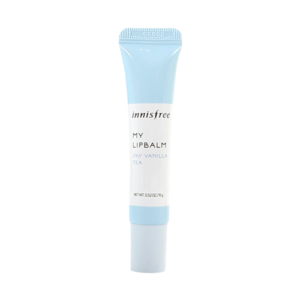
Reviewed in My Lip Balm #01 (Green Peppermint Tea).
Parfum generally stands for up to several hundred fragrance ingredients which may or may not be disclosed to the consumer. A 2016 review of natural personal care products performed an analysis of its ingredient lists. Of the 71 natural cosmetic products containing the word “parfum” – only 15 actually indicated that the “parfum” description actually encompassed essential oils.
Since the inclusion of fragrances in cosmetics, there have been many reports of increased allergic responses such as contact dermatitis. In fact, a 2014 review provided a two-part assessment of suspected fragrance allergens per the following: 1) Evaluation of the epidemiology of suspected fragrance allergens and 2) Reviewed screening methods, emerging fragrance allergens, and management of patients with fragrance contact allergy. The review recommended several prevention strategies to reduce exposure to allergenic fragrances while still enabling its applicable use.
Bottom line: Fragrance/parfum use is a tricky subject. Some don’t mind it, while others have intense responses to it due to contact dermatitis or other sensitivities.
Tocopheryl Acetate, Diisostearyl Malate, Titanium Dioxide (CI 77891), and Dehydroacetic Acid were reviewed in My Lip Balm #01 (Green Peppermint Tea).
Citric acid is a naturally-occurring organic acid (alpha hydroxy acid to be exact) present in many foods. Citric acid often functions as a chelating agent, pH adjuster, moisturizing agent, mild exfoliant, and fragrance ingredient in cosmetic formulations. In a 1988 study, citric acid was found to increase skin renewal rate and treat sun-damaged skin.
But just to drive the point further home, regarding citric acid, varying studies found the following:
- A 1996 study evaluated the effects of AHAs on photo-aged human skin through clinical and microanalytic means. Patients applied a lotion containing 25% glycolic, lactic, or citric acid (like what is included in this formulation? shocking!) to one forearm and a placebo lotion to the opposite forearm for an average of 6 months. Treatment with AHAs caused an approximate 25% increase in skin thickness with improved quality of elastic fibers and increased density of collagen.
- A 1997 study examined the effect of 20% citric acid lotion, as compared with vehicle alone, on skin thickness and viable epidermal thickness. Topical citric acid produces changes similar to those observed in response to glycolic acid, ammonium lactate, and retinoic acid including increases in epidermal thickness.
Bottom line: Mild exfoliant, skin conditioning agent, chelating agent, and pH adjuster in cosmetic products. Has been shown to increase elastic fibers, density of collagen, and skin thickness.
Just dyes/pigments – nothing much to discuss here. Is approved per the Personal Care Products Council and the FDA in the US.
Reviewed in My Lip Balm #01 (Green Peppermint Tea).
Just dyes/pigments – nothing much to discuss here. Is approved per the Personal Care Products Council and the FDA in the US.
Reviewed in My Lip Balm #01 (Green Peppermint Tea).
Reviewed in My Lip Balm #01 (Green Peppermint Tea).
However, one thing to note is when a product’s main or initial components tend to be water – there can be issues of bacterial contamination or growth. Unless there is some ingredient that may counter this within the formulation stability – such as a chelating agent.
Although water is listed in the middle of the ingredients list this formulation does have a chelating agent: citric acid.
Bottom line: Water is neither here nor there. And since water is not listed as one of the first ingredients — this addition doesn’t seem to do much for this lip balm formulation.
Reviewed in My Lip Balm #01 (Green Peppermint Tea).
We all know what vanilla is, but did you know that it gets its origins from the orchid family? At some point in our lives, we’ve associated the scent of vanilla with baked goods, ice cream (Häagen-Dazs for me!), candles, and perfumes. I must admit, there have been times that I’ve really detested the smell of vanilla. No actual reason. Just could not stand the smell. Then there have been times that the smell of vanilla brings be an absolute joy! As a result, vanilla is obviously used as a flavoring and fragrance agent.
But it does offer medicinal benefits:
- A 1998 study explored the protective effect of vanillin (a naturally occurring compound in vanilla beans) on radiation-induced chromosomal damage in cells. The study concluded that vanillin has the ability to reduce chromosomal damage caused by X-ray and UV light.
- A 2007 study evaluated the use of vanilla in food preservation. The study pointed to the potential use of vanilla extract components as antioxidants for food preservation and in health supplements as nutraceuticals.
One interesting side note is that vanilla is ranked second to saffron in terms of cost due to harvesting practices. Therefore, the high demand for vanilla extract is often supplied using synthetic vanillin (chemically produced from guaiacol and lignin).
As a result, of the high costs to extract plant-derived vanilla, modern technology by way of biotechnology has seemed to step in and offered alternatives, such as microbial production from phenolic stilbenes, lignin, eugenol, and ferulic acid.
Bottom line: Overall, vanilla oil (albeit costly to harvest) functions as a flavoring and fragrance agent with protective, antioxidant, and antimicrobial capabilities.
Phenoxyethanol is a preservative used to inhibit the growth of microorganisms in cosmetic products. Generally, a product formulated with high water content (is in this situation) is prone to the growth of microorganisms unless certain precautions or ingredients are added to thwart such problems.
However, overuse of preservatives within a formulation has also been shown to lead to increased incidences of contact allergy. Therefore, adding these ingredients poses the question of whether it is truly worth it.
Current concentration use in cosmetics based on a CIR assessment has indicated that phenoxyethanol may be used at a range of ≤ 0.0002% to 1%.
Bottom line: A preservative used to thwart the growth of microorganisms in high water content formulated products. No real benefit to claims with potential for skin irritations.
And ANOTHER preservative! However, ethylhexylglycerin (an alkyl glyceryl ether) has additional functionalities as a surfactant, emollient, and skin-conditioning agent – in addition to its antimicrobial properties.
Ethylhexylglycerin is a multifunctional additive for cosmetics and is used as a potentiating agent in combination with 2-phenoxyethanol (another preservative) to obtain better protection against microbial growth. A 2016 study investigated the mechanisms behind potentiation of the bactericidal effect of 2-phenoxyethanol, by ethylhexylglycerin. The study concluded that the synergy of ethylhexylglycerin and 2-phenoxyethanol led to rapid killing of E. coli – thereby providing microbial protection.
At the present moment, there have only been a few cases where contact allergy to ethylhexylglycerin have been published. In fact, a 2016 study evaluated 13 patients who reported allergic contact dermatitis caused by ethylhexylglycerin. The study was performed at two Belgian university patch test clinics during the period 1990–2015. The study identified ethylhexylglycerin as a cosmetic sensitizer even in those products advertised to be safe for consumers.
Bottom line: Ethylhexylglycerin is likely used as a preservative to thwart microbial issues within the formulation – but may also function as a surfactant, emollient, and skin-conditioning agent. As in many preservatives, ethylhexylglycerin may provide an allergic response to more sensitive consumers.
My Lip Balm #07 (Dried Rose Tea)
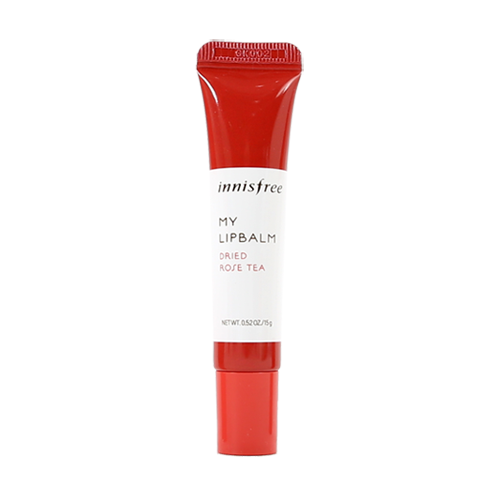
Reviewed in My Lip Balm #01 (Green Peppermint Tea).
Capric Triglyceride or Caprylic/Capric Triglyceride (CCT) is an emollient ester that was deemed as a safe ingredient to use in products per a safety assessment conducted in 1980 per the CIR panel.
Well, it’s been quite some time since 1980. And I am willing to bet that there have been cases reported and studies performed relative to this particular ingredient. In fact, most recently in 2017, the same CIR safety panel decided to re-evaluate and assess caprylic/capric triglyceride based on current clinical and animal data. And although the verdict isn’t necessarily in, I would be willing to bet the final assessment will deem this product safe as the origins of this ingredient come from benign oils.
Back to CCT (or sometimes known as caprylic acid) is a specific fraction of coconut/palm oil fatty acids – resulting in a stable form of esters. But how is this ingredient relevant to me?!
First, caprylic acid has been found and studied to have superior medical potential in anti-cancer, anti-Alzheimer’s, anti-Autism, and providing general circulatory improvement. But it also has potential beneficial applications as an anti-aging ingredient. Yessss!
Bottom line: Emollient ingredient derived from coconut and palm oil. Known for its skin-conditioning and anti-aging capabilities.
Isostearic acid was reviewed in My Lip Balm #01 (Green Peppermint Tea).
Fragrance/parfum was reviewed in My Lip Balm #02 (Sky Vanilla Tea).
Dimer dilinoleyl dimer dilinoleate functions as an emollient and viscosity controlling agent. Other than that, not much was really found on this specific compound as far as published studies or data.
Based on a trademarked vendor compound, dimer dilinoleyl dimer dilinoleate may be the following:
- Formed by the reaction of dimer dilinoleyl alcohol and dimer dilinoleic acid. Ideally suited for lipstick and make-up products. PELEMOL DD can be applied in lipsticks, lip balms, hair conditioners, mascaras and moisturizers.
Bottom line: Dimer dilinoleyl dimer dilinoleate is a emollient and viscosity controlling agent in cosmetics with not much public published studies to support any specific claims.
Just dyes/pigments – nothing much to discuss here. Is approved per the Personal Care Products Council and the FDA in the US.
CI 77491 (Red iron oxide)
Iron oxides are naturally sourced but synthetically processed. Therefore, most “natural” marketed beauty companies tend to utilize iron oxides in their formulations due to this “naturally” derived colorant source. Depending on the type of iron oxide, some varieties may have varying trace metals. Due to heavy regulations imposed by the FDA, iron oxides are generally safe as the trace amounts of metal are likely low.
Bottom line: Synthetically processed but naturally sourced ingredient used as a colorant or pigment in cosmetics. Although they do contain trace metals, due to heavy FDA regulations, the amount of allowable iron oxides in products is safe for consumers.
Tocopheryl Acetate, Titanium Dioxide (CI 77891), and Dehydroacetic Acid reviewed in My Lip Balm #01 (Green Peppermint Tea).
Red 27 (CI 45410) and Citric Acid reviewed in My Lip Balm #02 (Sky Vanilla Tea).
We’ve reviewed varying forms of rose flower oil but this doesn’t seem to be very specific to which type of rose oil used in the formulations.
Regardless, where would aromatherapy be without the smell of the rose?
For centuries, humans have studied every aspect of this plentiful flower. The rose and its petals are often a symbol of love. In a 2007 study, 95 macro and micro components in the essential oil of Rosa Damascena (R. damascena) from central Iran. The identified components were β-citronellol (14.5-47.5%), nonadecane (10.5-40.5%), geraniol (5.5-18%), and nerol and kaempferol were the major components of the oil.
In addition, some of the medicinal effects that stem (pun intended) from the R. damascena are partly attributed to their abundance of phenolics compounds – resulting as strong antioxidants, free-radical scavengers, and exhibiting anti-inflammatory/anti-mutagenic/anti-depressant capabilities.
In addition, rosa canina (rosehip) has long been used for its medicinal properties and often functions as a skin conditioning agent, fragrance ingredient, astringent, anti-acne agent, humectant, and exfoliant in cosmetic products.
The results of a fatty acid analysis indicated that Rosa canina contains the following most abundant fatty acids: linoleic acid (35.9–54.8%), α-linolenic acid (16.6–26.5%), and oleic acid (14.7–22.1%). These essential fatty acids are the precursors for omega-3 (linolenic acid and linoleic), 6 (linoleic), and 9 (oleic) which have been shown to in studies to improve skin hydration and elasticity. And studies have concluded that fatty acids (such as linolenic acid) contained in a majority of these oils create a film on the skin which reduces transepidermal water loss (TEWL), thus contributing to maintaining the correct hydration of the epidermis.
The rosa canina seeds and shells also contain high amounts of carotenoids (precursors of vitamin A and high amount of vitamin E). Many studies have pointed to such vitamins to support skin maintenance – with Vitamin A stimulating the cells of the skin, restoring damaged skin cells and therefore, making a brilliant anti-aging ingredient.
With its high composition of fatty acids and antioxidants, this oil has relatively high protection against inflammation and oxidative stress.
Bottom line: Rosa canina functions as a skin conditioning agent, fragrance ingredient, astringent, anti-acne agent, humectant, and exfoliant in cosmetic products. Due to its high essential fatty acid content, Vitamin A and Vitamin E content – it often provides anti-inflammatory and antioxidant capabilities. It has also been shown to improve skin hydration and elasticity. In the end, the essential oil is packed with phenolic compounds and has a strong antioxidant capacity.
Reviewed in My Lip Balm #02 (Sky Vanilla Tea).
Just dyes/pigments – nothing much to discuss here. Is approved per the Personal Care Products Council and the FDA in the US.
Reviewed in My Lip Balm #01 (Green Peppermint Tea).
My Lip Balm #08 (Sun Kissed Cherry Tea)
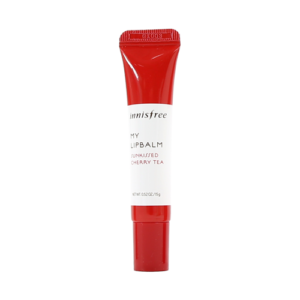
Petrolatum, Hydrogenated Castor Oil Dimer Dilinoleate, Microcrystalline Wax, Beeswax, Simmondsia Chinensis (Jojoba) Seed Oil, Helianthus Annuus (Sunflower) Seed Oil, Theobroma Grandiflorum Seed Butter, Silica Silylate, Diisostearyl Malate, Isostearic Acid, Tocopheryl Acetate, Dehydroacetic Acid, Titanium Dioxide (CI 77891), Sodium Saccharin, Tocopherol, Butylene Glycol, Glycerin, Camellia Sinensis Leaf Extract, Citrus Unshiu Peel Extract, Opuntia Coccinellifera Fruit Extract, Orchid Extract, and Camellia Japonica Leaf Extract, and Citrus Sudachi Fruit Extract were reviewed in My Lip Balm #01 (Green Peppermint Tea).
Caprylic/Capric Triglyceride, Dimer Dilinoleyl Dimer Dilinoleate, Red 6 (CI 15850), Red 7 Lake (CI 15850), and Iron Oxides (CI 77492) were reviewed in My Lip Balm #07 (Dried Rose Tea).
Fragrance /parfum, Red 27 (CI 45410), Citric Acid, and Water / Aqua / Eau were reviewed in My Lip Balm #02 (Sky Vanilla Tea).
Fragaria vesca (woodland strawberry) fruit extract often functions as a skin-conditioning, emollient, moisturizing agent, and an antioxidant in cosmetics. This ingredient has been identified as safe by the CIR panel.
Strawberries are often known for an abundance of ellagic acid and flavonoids (anthocyanin, catechin, quercetin, and kaempferol) which have are potent antioxidants. Anthocyanin, a water-soluble flavonoid pigment is responsible for the colors (red, blue, purple) of many fruits, flowers, leaves, and seeds.

In fact, a 2017 study tested the efficacy of a strawberry-based formulation supplemented with Coenzyme Q10 and sun protection in human dermal fibroblasts irradiated with ultraviolet-A (UVA)-radiation. The results suggested that use of strawberry-based formulations was an “innovative, natural, and useful tool” for the prevention of UVA exposure-induced skin diseases. The study also concluded that strawberry-based formulations would provide as a good natural substitute for synthetic sunscreen agents.
Although anthocyanins contribute to many health benefits; it is important to note that they are limited by bioavailability and instability when exposed to oxygen, heat, and light which may be eliminated due to applying fermentation.
Bottom line: Fragaria vesca (strawberry) fruit extract often functions as a skin-conditioning, emollient, moisturizing agent, and an antioxidant in cosmetics. It may provide as a natural alternative to synthetic sunscreen agents.
Various studies have suggested that citrus aurantium used for aromatherapy purposes showed a decrease in anxiety and stress levels. So whether these citrus oils are simply added to calm your anxious senses and mind as part of the skincare treatment process – we will never know. But the fragrance and aroma offers such a relaxing component – don’t you think?
Bottom line: Used for its aroma and stress/anxiety reduction. Strong anti-inflammatory effect.
Prunus avium (sweet cherry) fruit extract often functions as a skin-conditioning, emollient, moisturizing agent, and antioxidant in cosmetics. This ingredient has been identified as safe by the CIR panel.
This specific type of cherries (sweet cherries) is particularly interesting in that only 5 countries are the primary producers: Turkey, United States, Iran, Italy, and Spain.
Sweet cherries are an excellent source of bioactive molecules and antioxidant compounds such as carotenoids and unsaturated fatty acids. And much like strawberries, cherries contain polyphenols (flavonoids, anthocyanins, and hydroxycinnamic acids) as well as high levels of ascorbic acid and potassium. In fact, the seed oils can be used as preservatives and as ingredients in food, pharmaceutical actives, and cosmetic components.

A 2015 study compared the physico-chemical and biochemical properties of pomegranate (punica granatum), sweet cherry (prunus avium) and pumpkin (cucurbita maxima) seed oils obtained by solvent extraction. The results from the study determined that cherry and pumpkin seed oils contained high amounts of linoleic acid, 41.45% and 47.45%, respectively. In addition, the following high percentage of fatty acid composition was confirmed for sweet cherries:
- Oleic acid: 35.05%
- Palmitic: 9.05%
- Saturated fatty acids: 12.20%
- Monounsaturated fatty acids: 39.49%
- Polyunsaturated fatty acids: 44.32%
The 2015 study also evaluated the antioxidant activity of pomegranate, sweet cherry, and pumpkin seed oils by using the free radical 2,2-diphenyl-1-picrylhydrazy (DPPH) assay. The results from the study determined that cherry (96.23%) and pomegranate (96.80%) seed oils exhibited significant antioxidant activity as compared to pumpkin (25.87%) seed oils; which may be correlated with hydrophilic antioxidant components such as polyphenols.
Bottom line: Sweet cherries functions as a skin-conditioning, emollient, moisturizing agent, and antioxidant in cosmetics. They exhibit high amounts of linoleic acid and oleic acid.
THE CLAIMS
All balm flavors claim the following:
“My Lip Balm hydrates dry lips by creating a non-greasy barrier.
My Lip Balm can also be applied to cheeks for a hydrated, dewy flush.
Tea complex helps prevent moisture from evaporating.
Sunflower seed oil, cupuacu butter and jojoba oil coat lips for long-lasting hydration.”
Ok, the claims as detailed on the Innisfree My Lip Balm website for the following:
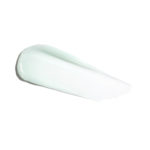
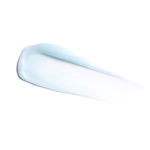
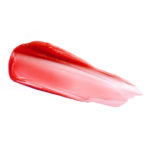
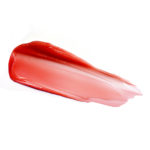
Ok, let’s parse this baby to its bare bones based on its ingredients:
| Substantiated | Claims | What's the Problem? |
|---|---|---|
👍🏻 | Hydrates dry lips by creating a non-greasy barrier. | None |
👍🏻 | Can also be applied to cheeks for a hydrated, dewy flush. | None |
👍🏻 | Tea complex helps prevent moisture from evaporating. | None |
👍🏻 | Long-lasting hydration with: Sunflower seed oil, cupuacu butter, and jojoba oil. | None |
SKIN TYPE & USE
According to Innisfree, the balms were formulated and should be applied per the following:
“Apply to lips any time for a boost of hydration and a soft wash of color. Use over any lipstick to create a glossy look. Dab on the cheeks for a hydrated, dewy flush.”
Pretty self-explanatory and doesn’t need more clarification.
THE GOOD & THE BAD
Like Glossier Balm Dotcom, there was a definite base formation that continued throughout all four of the flavors. Those base ingredients included:

Irrespective of the base formulation, the following ingredients provided distinguishable flavor components which separated each balm:
- Pigments/dyes
- Appropriate flavor extracts/oils
Similar to my review for the Glossier Balm Dotcom, a critical complaint is the addition of the parfum/fragrance ingredient. But unlike Glossier Balm Dotcoms, the Innisfree My Lip Balms incorporate the addition of extracts and oils appropriate to each relatable flavor:
- #01 (Green Peppermint Tea): Mentha Viridis (Spearmint) Leaf Oil
- #02 (Sky Vanilla Tea): Vanilla Planifolia Fruit Extract
- #07 (Dried Rose Tea): Rose Flower Oil
- #08 (Sun Kissed Cherry Tea): Prunus Avium (Sweet Cherry) Fruit Extract
Though, unlike Glossier Balm Dotcom the use of preservatives was thrown into the gauntlet:
- Dehydroacetic acid
- Phenoxyethanol
- Ethylhexylglycerin
And then there were ingredients that did not have publicly available research or data (outside of vendor-specific claims) to provide insight into the true value of its use:
- Diisostearyl malate
- Dimer dilinoleyl dimer dilinoleate
And finally, the use of sodium saccharin.
I suppose Innisfree wanted to impart that sugary taste into their lip balm. However, as I said before, I’d gladly relinquish any sugary taste or smell if it meant NOT using this artificial sweetener with varying studies pointing to it its carcinogenic capacity.
THE UGLY (PRICE)
My Lip Balm
#01 (Green Peppermint Tea) ($10)
#02 (Sky Vanilla Tea) ($10)
#07 (Dried Rose Tea) ($10)
#08 (Sun Kissed Cherry Tea) ($10)
DO I NEED THIS?
In the end, these are lip balms. And they do contain both botanical and synthetic ingredients. And as mentioned before, the lip balm market is massive and extends to all varieties, for every age group, with ranging price points.
So whether you choose to spend $10 for a tube of Innisfree My Lip Balm, purchase other alternatives (see Dupes), or head to your local drugstore — the choice is yours.
DUPES
#01 (Green Peppermint Tea):
100% Pure Organic Mint Lip Balm
100% Pure Sweet Mint Lip Balm SPF 15
Glossier Balm Dotcom (Mint) (Reviewed here)
#02 (Sky Vanilla Tea):
Glossier Balm Dotcom (Birthday Cake) (Reviewed here)
#07 (Dried Rose Tea):
Babo Botanicals Lip Tint Conditioner SPF 15
Glossier Balm Dotcom (Rose) (Reviewed here)
Herbivore Botanicals Coco Rose Lip Tint – Coral
#08 (Sun Kissed Cherry Tea):
Glossier Balm Dotcom (Cherry) (Reviewed here)
ARE THE CLAIMS BACKED BY SCIENCE?
Overall, the claims were very general. To be quite honest, one would hardly call them claims.
As usual, my advice would be to take heed to what can be drawn from some of these ingredients.
Is it worth the sacrifice if there is no plausible benefit? In the end, these are decisions that we must make and decide individually.
The reality is how you go about selecting those products which contain ingredients that inevitably penetrate your skin. Some deem certain ingredients as deal breakers, while others don’t see it as a means of purchasing priority.
As always, the choice is yours.
Until my next review!

